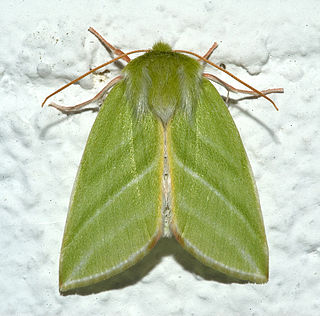
The red underwing is a moth of the family Erebidae. The species was first described by Carl Linnaeus in his 1767 12th edition of Systema Naturae.

The scalloped oak is a moth of the family Geometridae. The species was first described by Carl Linnaeus in his 1758 10th edition of Systema Naturae.

Plagodis pulveraria, the barred umber, is a moth of the family Geometridae. The species was first described by Carl Linnaeus in his 1758 10th edition of Systema Naturae. It is found throughout much of the Palearctic realm from Ireland to Japan, and in the Nearctic realm (Canada).

Herminia grisealis, the small fan-foot, is a litter moth of the family Erebidae. It is found in Europe. The eastern expansion is across the Palearctic to the Ussuri River and after that Japan. In the Alps it rises up to a height of 1300 meters.

Setina irrorella, the dew moth, is a moth of the family Erebidae. The species was first described by Carl Linnaeus in his 1758 10th edition of Systema Naturae. It is found in the Palearctic from Ireland, then through Europe and east to northern and central Asia to the Pacific Ocean. It is missing in the high north and parts of the Mediterranean region. It is found also in the limestone Alps up to 2,000 meters above sea level.

Miltochrista miniata, the rosy footman, is a moth of the family Erebidae. The species was first described by Johann Reinhold Forster in 1771. It is found in the temperate parts of the Palearctic realm – Europe, Asia Minor, Caucasus, northern Kazakhstan, southern Siberia, Amur, Primorye, Sakhalin, southern Kuriles, Heilongjiang, Liaoning, Hebei, Inner Mongolia, Shanxi, Sichuan, Korea and Japan, but may be replaced by Miltochrista rosaria in the eastern Palearctic.

Pseudoips prasinana, the green silver-lines is a moth of the family Nolidae, common in wooded regions, and having a wingspan of 30–35 mm. It is found in the Palearctic realm.

Catocala electa, the rosy underwing, is a moth of the family Erebidae. The species was first described by Karl Friedrich Vieweg in 1790. It can be found in Europe and Asia.

Spirama helicina is a moth of the family Erebidae first described by Jacob Hübner in 1824. In older texts, the species was classified as morph of Spirama retorta.

Eudocima phalonia, the common fruit-piercing moth, is a fruit piercing moth of the family Erebidae. The species was first described by Carl Linnaeus in his 1763 Centuria Insectorum. It is found in large parts of the tropics, mainly in Asia, Africa and Australia but introduced into other areas such as Hawaii, New Zealand and the Society Islands. It is one of major fruit pests in the world.

Calyptra minuticornis, the vampire moth, is a moth of the family Erebidae. It has been found in Indonesia, Java, India, Sri Lanka, and Australasia.
Lyonetia euryella is a moth in the family Lyonetiidae. It is known from the islands of Honshu, Kyushu and Yakushima in Japan.

Sabatinca heighwayi is a species of moth belonging to the family Micropterigidae. It was described by Alfred Philpott in 1927 and is endemic to New Zealand. It can be found north of Lewis Pass in the north west of the South Island. Adult moths are on the wing from late September until the middle of January. The host of the larvae of this species is the foliose liverwort Plagiochila circumcincta.

Oraesia emarginata is a species of moth of the family Erebidae first described by Johan Christian Fabricius in 1794. It is found in Australia, New Caledonia, Indonesia, New Guinea, Pakistan, the Philippines, India, Sri Lanka, Sulawesi, Taiwan, China, Japan, Korea and Nepal as well as Eritrea, Ethiopia, Kenya, Namibia, Nigeria, South Africa, Tanzania, the Gambia, Uganda, Oman and Yemen.
Nannoarctia himalayana is a moth of the family Erebidae first described by Vladimir Viktorovitch Dubatolov, Patrick G. Haynes and Yasunori Kishida in 2010. It is found in Nepal and India.

Erebus hieroglyphica is a moth of the family Erebidae. It is found from the Oriental tropical countries such as India, Pakistan, Sri Lanka, Bangladesh, Japan, China, Taiwan, Cambodia, Laos, Myanmar, Thailand, Vietnam, Indonesia, Philippines, Malaysia, Singapore, and Korea. The habitat consist of lowland forests.

Nordstromia bicostata is a moth in the family Drepanidae. It was described by George Hampson in 1912. It is found in Sikkim in India, Sichuan in China, Nepal and northern Myanmar.
Nordstromia humerata is a moth in the family Drepanidae. It was described by Warren in 1896. It is found in north-eastern India.
Stenoglene citrinus is a moth in the family Eupterotidae. It was described by Druce in 1886. It is found in Cameroon, the Central African Republic, the Democratic Republic of Congo, Gabon and Nigeria.
Imma hemixanthella is a moth in the family Immidae. It was described by William Jacob Holland in 1900. It is found on Buru in Indonesia.















